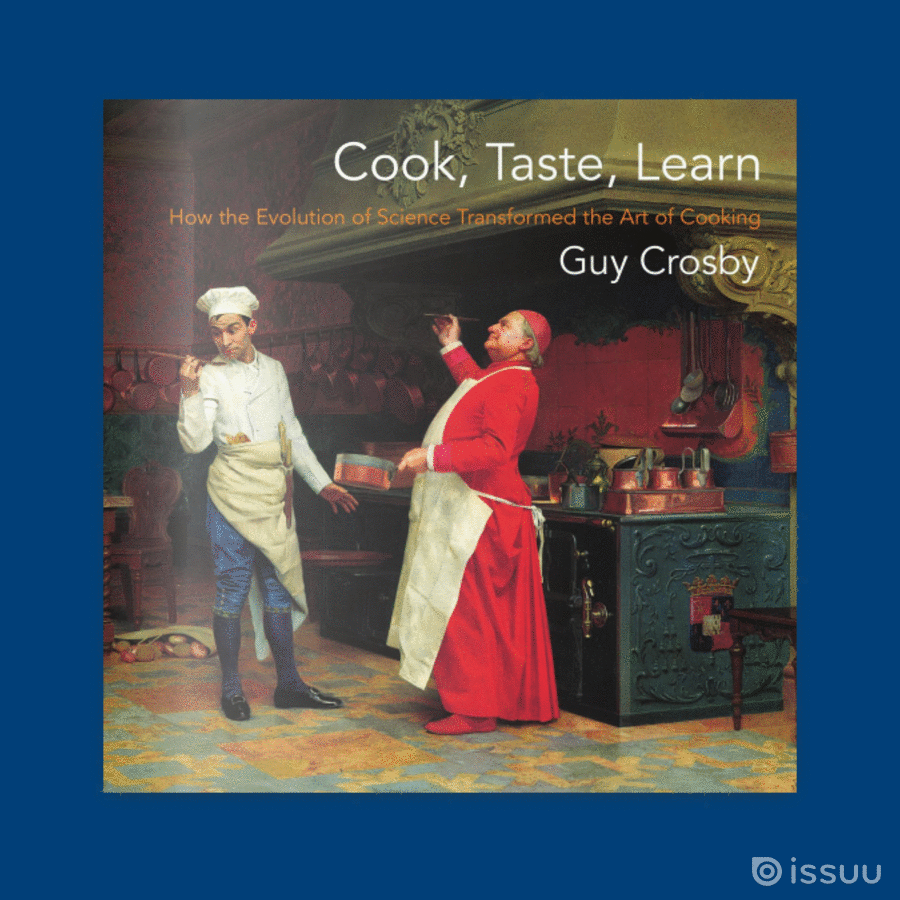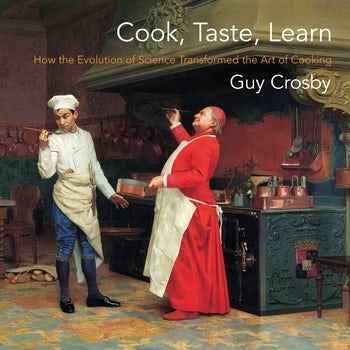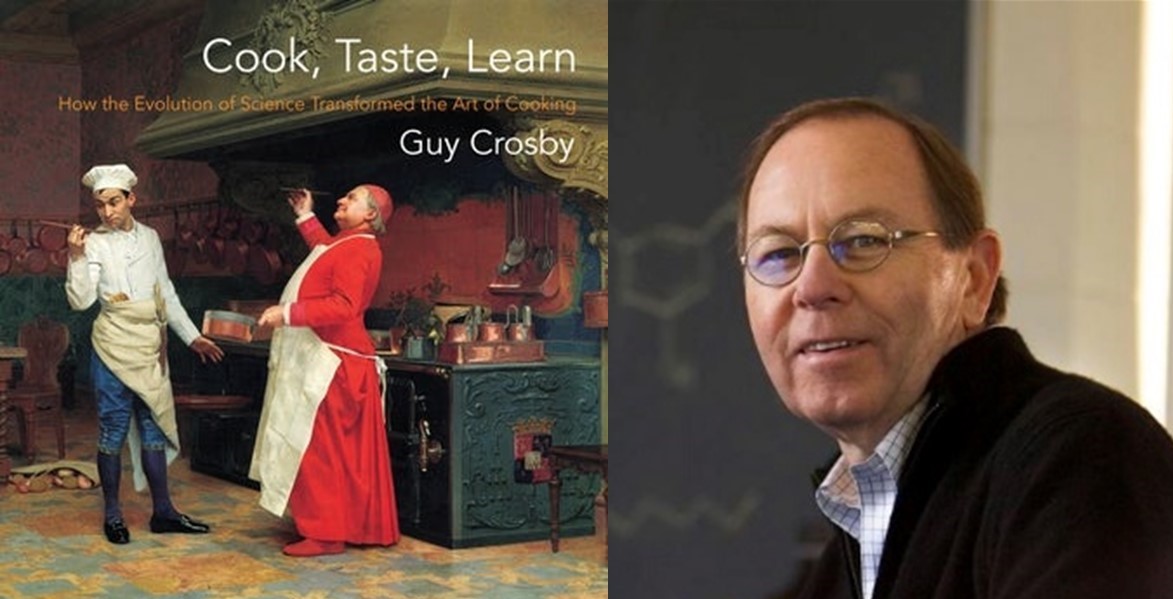Guy Crosby on the History and Future of Food

“As a foodie myself I was delighted to see all suspicions confirmed in Cook, Taste, Learn—that advances in the culinary arts are commonly empowered by curious scientists who also happen to be hungry.”
~Neil deGrasse Tyson, American Museum of Natural History
In this guest blog post, Guy Crosby, author of Cook, Taste, Learn: How the Evolution of Science Transformed the Art of Cooking, discusses food on a level deeper than most. The meals we eat every day have a rich history and a dynamic future. Crosby gives a brief overview of the history of cooking and explains how important it was to human evolution. Learn how food has evolved, too, in methods of cooking to enhance its nutritional quality.
Enter this week’s book-giveaway drawing for a chance to win a copy of Cook, Taste, Learn!
• • • • • •
It’s truly amazing when you think about it—of all the many thousands of species living on earth only humans cook their food! Professor Richard Wrangham, one of the world’s leading anthropologists, believes that some of our earliest ancestors began using fire to cook food almost 2 million years ago, resulting in bigger brains and an evolutionary advantage over all other species. Cooking provided pleasure, better nutrition and health, safety, and an undeniable effect on social behavior. This startling concept provided the seed for my new book Cook, Taste, Learn: How the Evolution of Science Transformed the Art of Cooking.
Yet despite the profound impact of cooking on human evolution, many anthropologists believe the dawn of agriculture about 10,000 years ago was the single greatest technological advance of humankind. Enough food could be harvested in three weeks to last a family for a whole year, resulting in permanent settlements, greater safety, and more time for innovation and childbirth. During the relatively brief 5000 to 7000 years following the evolution of agriculture, the world’s population is estimated to have grown from 3 million to 100 million people, or about 35 times greater than the sustained level of the preceding millennia! During that time, known as the Neolithic period, the abundance and variety of food and methods of cooking increased dramatically, as evidenced by some of the earliest known recipes recorded almost 4000 years ago in Mesopotamia, between the Tigris and Euphrates rivers.
“During the relatively brief 5000 to 7000 years following the evolution of agriculture, the world’s population is estimated to have grown from 3 million to 100 million people, or about 35 times greater than the sustained level of the preceding millennia!”
The evolution of the science of cooking is a much more recent development having commenced between 1600 and 1800, when the scientists of that period came to understand the true nature of combustion, an essential element of cooking, as a chemical process that generates heat and light rather than a physical substance. Discoveries in the science of pressure and vacuum also elucidated during this period led to the development of the first pressure cooker in 1680, followed by the concept of sous vide cooking in 1799, and the invention of canning food around the same time. Then in 1805, John Dalton, a quiet, color-blind meteorologist from Birmingham, England, developed the modern concept of atomic theory, changing science forever. It became possible to understand food on a molecular level, leading to great advances in cooking such as the creation of nouveau cuisine by the “King of Chefs” Marie-Antoine Careme, who practiced both the art and science of cooking during the early 1800s.
Emma Eaton Kellogg published her revolutionary book Science in the Kitchen in 1892, establishing a precedent for the application of science to the creation of nutritious healthy recipes for invalid soldiers. Science-driven cooking was taking a new direction, from the preparation of hardy wholesome dishes to one of nutritious healthy food. In 1953 John Edward Hodge, an African American chemist working for the United States Department of Agriculture, published his seminal paper on the chemistry of flavor development that turned the world of flavor chemistry upside down, enabling future chefs to create new mouthwatering dishes. Cooking was evolving from an art to a science, which is why I enjoy cooking so much.
But what do we mean when we say cooking is an art? In the 1970s artist Martha Rosler wrote a fictitious conversation between Julia Child and the food critic Craig Claiborne entitled “The Art of Cooking” (for the full impact try reading Julia’s lines in her distinctive high-pitched voice):
Julia Child: Craig my dear, I’ve been thinking. We all know that cooking is an art. But I wonder: How did it get to be one? After all, most of what we think of as art hangs on the wall or sits out in a courtyard.
Craig Claiborne: Yes Julia, cooking is an ephemeral art; the painter, the sculptor, the musician may create enduring works, but even the most talented chef knows that his or her masterpieces will quickly disappear. A bite or two, a little gulp, and a beautiful work of thought and life is no more.
Today one of my passions is pairing the science of cooking with the science of nutrition to create dishes that not only are delicious but also enhance the nutritional quality of food. Cooking science teaches us how to minimize the loss of essential nutrients such as vitamins and minerals while also increasing the bioavailability of healthy phytochemicals such as antioxidants and soluble fiber that reduce the risk of diabetes, heart disease, cancer, and dementia. Another of my passions from an early age is painting, as reflected in some of my original art that appears throughout the book.
The future of cooking science will not be driven by how to cook a tender juicy steak, make the perfect pie dough, or kick up the flavor of our favorite dish but how to optimize the nutritional quality of the food we cook. As you will learn in my book, science-driven changes in the way we cook food will reduce the risk of developing a number of chronic diseases and increase the quality of life. It’s like having your cake and eating it, too.
Explore more books in the Arts and Traditions of the Table: Perspectives on Culinary History series, and save 30% when you order from our website by using coupon code: CUP30 at checkout!





